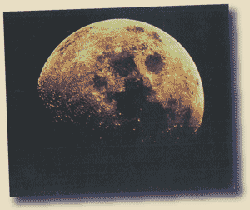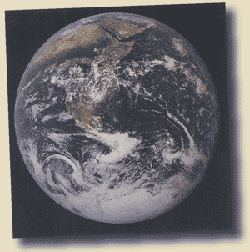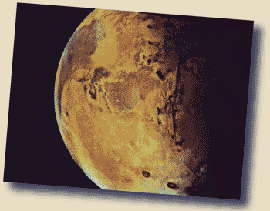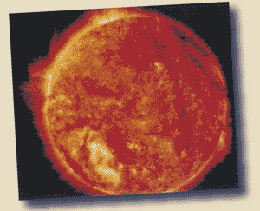| Approach: One
to one |
Level:
Year 4
and year 8 |
|
| Focus:
Solar
system
|
| Resources:
4 pictures
|
 |
676KB |
|
|
| Questions/instructions:
In this activity
we’ll talk about the moon, the sun, Earth and Mars. |
| |
%
responses
2003 ('99) |
| y4
|
y8 |
 Show
student moon (picture 1). Show
student moon (picture 1).
Here is a picture of the moon. |
|
|
1.
What is the moon?
Try to tell me all that you know about the moon.
|
satellite
of the Earth
(travels round the earth) |
12
(8) |
33 (26) |
smaller
than Earth |
2
(3) |
8 (5) |
made
of rocky materials |
17
(11) |
18
(17) |
about
400,000kms from Earth |
0
(0) |
0
(0) |
reflects
sun onto Earth (provides light at night) |
12 (8) |
22
(16) |
has
lots of craters |
35
(36) |
42
(42) |
has
no atmosphere/oxygen/ air/ozone/clouds, etc. |
9
(21) |
17 (21) |
any
other valid scientific response (not myths or historical
events) |
9 (10) |
10
(6) |
2.
Imagine you have arrived on the moon.
What would you notice that is different from being on planet Earth?
|
no
atmosphere/oxygen/air |
31 (30) |
45
(45) |
black
sky all the time |
10 (8) |
10
(7) |
you
can see the earth from there |
1 (0) |
3
(3) |
less
gravity than on Earth |
6 (4) |
16 (11) |
[no
gravity] |
[25 (21)] |
[37 (29)] |
no
vegetation/animals/people |
34
(33) |
44
(40) |
rocky/dusty/barren
landscape |
27
(30) |
45
(34) |
no
water |
16 (11) |
18
(18) |
3.
How is it that we can see the moon with our eyes?
Prompt: What makes the moon visible to us?
|
light
of sun reflected from moon |
23 (25) |
42
(46) |
4.
Why do you think that the moon appears to change its shape?
Prompt: Try to explain why the moon looks different at different times
of the month or year.
|
part
seen (as bright) depends on relative
positions of sun, moon and earth |
6
(5) |
18
(17) |
has
idea, but not well explained |
16
(29) |
29
(33) |
| Show
student Earth (picture 2) and Mars (picture 3). |
 |
 |
Here is a picture of
planet Earth and a picture of planet Mars.
Scientists tell us that people like us cannot live on Mars but we know
that we can live on planet Earth. |
|
|
5.
Why can’t people live on planet Mars?
Tell me as many reasons as you can think of.
|
Temperature:
(very hot during day, cold at night) |
|
|
both
|
3
(0) |
5
(7) |
just
one |
52
(56) |
59
(51) |
atmosphere
issues |
51
(47) |
73
(71) |
lack
of water |
34 (25) |
50 (46) |
lack
of food |
24
(19) |
22
(13) |
6.
Why are we able to live on planet Earth?
Tell me as many reasons as you can think of.
|
temperature
suits our bodies |
21
(24) |
30 (26) |
air/oxygen/atmosphere
|
52
(59) |
78
(72) |
water |
57 (46) |
72
(67) |
food
sources |
37
(32) |
41
(29) |
 Show
student Sun (picture 4). Show
student Sun (picture 4).
Here is a picture of the sun. |
|
|
7.
The sun is not a planet. What is the sun?
|
star
|
41
(34) |
57
(28) |
ball
of fire/gases |
29
(27) |
26
(47) |
8.
How is the sun different from planet Earth?
|
much
bigger |
13 (8) |
24 (15) |
extremely
hot/ball of fire |
84
(82) |
91 (85) |
no
life or life requirements
(e.g. water/oxygen) |
22 (16) |
37
(28) |
no
well defined surface (outer layers gas/plasma rather
than solid/liquid) |
6
(4) |
15
(3) |
| |
|
|
Total
score:
|
20–33
|
1
(0) |
7
(0) |
16–19
|
5
(4) |
20
(14) |
12–15
|
21
(17) |
29
(29) |
8–11 |
33 (36) |
25
(28) |
4–7
|
28
(29) |
16
(24) |
0–3
|
12
(14) |
3
(5) |
Commentary
Between 1999 and 2003, there has been very little change in performance
for year 4 students, but a small increase for year 8 students. |